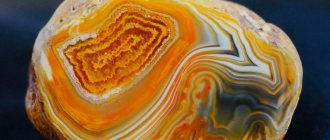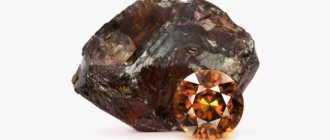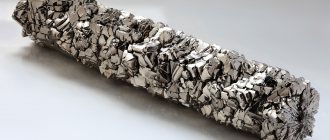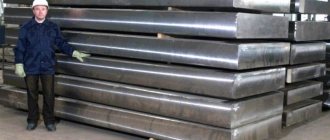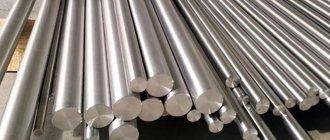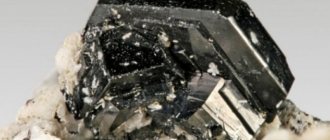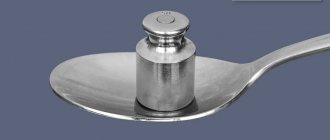Titanium deposits
Titanium is used in metallurgy, medical technology, jewelry and dyeing industries.
Titanium is a light-colored metal. Element of the periodic table with atomic number 22.
Titanium deposits are located in Russia, China, Kazakhstan, Ukraine, South Africa, Brazil, India, Japan, Australia, Ceylon, and South Korea. Russia currently has the world's second largest reserves of titanium after China. Russia's titanium base consists of 20 deposits dispersed throughout the country.
The Krasnoyarsk region has a significant titanium raw material base. The deposits are located in the Eastern Sayan (Lysan group), on the Siberian platform (Madashenskoye) and in the province. Balance reserves of titanium dioxide are 57.8 million tons.
The Lysan deposit in Eastern Sayan is more studied. 12 ore bodies, including ilmenite ores, have been identified at the deposit. The ores are complex and can be used in metallurgical production with associated titanium extraction. Balance sheet reserves of titanium dioxide in category A+B+C1 are 4.4 million tons, off-balance sheet reserves are 3.2 million tons.
The most promising alluvial titanium deposit for industrial development is the Madashenskoe occurrence on the right bank of the Angara, on the watershed of the Noida, Inchanba and Madashen rivers. It was discovered in 1963 during prospecting for bauxite. The ore-bearing horizon is composed of heterogeneous sands with a thickness of 1 to 32 m. Ore minerals are represented by ilmenite and leucoxene, concentrated in natural concentrates in the form of thin lens-shaped layers. The predicted resources are 5.7 million tons with an average content. The area of sand development is about 40 square meters. km.
In the province, the Guli massif is of interest; the forecast of titanium dioxide resources is 9 million tons with a TiO2 content of 5.92%.
Source
Physical properties
The element is located in the fourth group in the system of D.I. Mendeleev, at number 22. In the compound, the atom has valency (II). The electronic configuration is represented by the formula: [Ar] 3d24s2.
Atomic weight (mass) is about 47.9 amu. The transition of alpha titanium to beta titanium occurs at a temperature of 8830C. The heat of fusion is 18.8 kJ/mol. Boils at 31800C. It has a thermal conductivity of 22.09 W/(m*K).
Titanium has high malleability, ductility, and low hardness. However, alloys containing titanium are highly hard but brittle compounds.
The silvery substance, related to metals in structure, has a bluish tint. Has low density. High melting point (16700C).
In compounds, Ti can exhibit an oxidation state of (+2) (Ti+2H2, Ti+2O, Ti+2(OH)2, Ti+2F2, Ti+2Cl2, Ti+2Br2), (+3) (Ti+32O3, Ti+3(OH)3, Ti+3F3, Ti+3Cl3, Ti+32S3) and (+4) (Ti+4F4, Ti+4H4, Ti+4Cl4, Ti+4Br4).
TITANIUM. World ranking of countries. year 2012
The world's main producers of titanium concentrates are ten countries, which in 2012 accounted for 94% of the production of ilmenite, 90% of rutile and 100% of leucoxene concentrates.
The producing countries of titanium concentrates are divided into two large groups.
The first group includes countries in which titanium is mined mainly from igneous deposits. In Canada, the largest producer of ilmenite concentrates (22% of world production), the world's richest ores (34% TiO2) of the giant Lac Thio ilmenite deposit are developed. China also produces 10% of the world's output of ilmenite concentrates from ores of ilmenite-titanium magnetite deposits, including the giant Panzhihua deposit, the ores of which contain 12% TiO2. Norway produces 8% of the world's output of ilmenite concentrates from high-grade ores (18% TiO2) of the giant Tellnes ilmenite-titanium magnetite deposit.
The second group includes countries that mainly exploit alluvial deposits. Among them, the largest producer of ilmenite (11.5% of world output), rutile (57%) and leucoxene (100%) concentrates is Australia, where numerous modern, mainly coastal-marine placers are developed - surface, near-surface, and deep-lying . South Africa produces 12% of ilmenite and 16% of rutile concentrates also from ore sands of modern surface coastal-marine placers.
Vietnam has fairly modest titanium dioxide resources, but all of them are located in easily accessible modern coastal-marine placers located along the coast of the South China Sea. This country accounts for about 8% of the world's production of ilmenite concentrates.
Large titanium dioxide resources, mainly in coastal-marine placers, including two giant producing deposits with rich ores, Chatrapur and Chavara, allow India to produce 6% ilmenite and 3% rutile concentrates.
Mozambique and Madagascar also have significant resources of titanium dioxide in placers.
The titanium dioxide resources of Ukraine are contained in both magmatic and placer deposits, but only buried coastal-marine and alluvial placers confined to the northern edge of the Ukrainian shield are being developed.
Recently, due to the shortage of titanium raw materials, interest in magmatic deposits has increased in the world. The most intensive geological exploration work aimed at discovering deposits of this type is carried out in Australia and Canada, as well as in Finland, Ukraine, Norway, and Chile. A new type of titanium deposits was discovered in Paraguay, where a giant group of Alto Parana deposits was discovered in the weathering crust of tholeiitic basalts with ores containing 7.6% TiO2.
The Canadian company Argex Titanium has developed a new process for the production of high-purity titanium dioxide (99.8% TiO2) directly from ilmenite-titanium magnetite ores containing 18-19% TiO2 at atmospheric pressure and low temperatures. The process extracts iron, titanium and vanadium directly from mined ore in a single process.
The University of Cambridge has developed a process for producing titanium metal from finely divided rutile concentrate obtained from ore from the Chilean Cerro Blanco deposit. The new technology is single-stage and requires four times less cost than traditional technology. This may in the future change the balance of power in the global titanium industry.
Source
Production of titanium and its alloys: features of the technological process
Titanium is one of the most important structural materials because it combines strength, hardness and lightness. However, other properties of the metal are very specific, which makes the process of obtaining the substance difficult and expensive. And today we will consider the global technology for the production of titanium, we will briefly mention its properties and the scope of application of products.
Chemical properties
It is resistant to corrosion and has properties similar to chromium-nickel steel. The latter is due to the film formed on its surface. Air does not change mechanical properties.
When heated above 6000C, the metal becomes brittle and oxygen absorption increases. When heated above 9100C, it interacts with gaseous carbon compounds and reabsorbs nitrogen.
When hydrogen is added, titanium acquires “hydrogen embrittlement.” This effect is manifested by increased fragility during voltage surges. Resistant to acids.
Titanium production
The use of metal began only in the 50s of the last century. Its extraction and production is a complex process, due to which this relatively common element was classified as conditionally rare. And then we will look at the technology and equipment of titanium production shops.
Raw materials
Titanium ranks 7th in terms of abundance in nature.
Most often these are oxides, titanates and titanosilicates. The maximum amount of the substance is contained in dioxides - 94–99%. The most important deposits are ilmenite, rutile and titanomagnetite. They are divided into 3 groups:
The development of primary deposits is associated with the sinking of mines. The resulting ore is crushed and enriched on site. Gravity enrichment, flotation, and magnetic separation are used.
Titanium slag can be used as a feedstock. It contains up to 85% metal dioxide.
Receiving technology
The process of producing metal from ilmenite ores consists of several stages:
The process is complex, multi-stage and expensive. As a result, a fairly affordable metal turns out to be very expensive to produce.
This video will tell you about the production of titanium:
Receiving slag
Ilmenite is an association of titanium oxide with ferrous iron. Therefore, the purpose of the first stage of production is to separate the dioxide from the iron oxides. To do this, iron oxides are reduced.
The process is carried out in electric arc furnaces. The ilmenite concentrate is loaded into the furnace, then a reducing agent is introduced - charcoal, anthracite, coke, and heated to 1650 C. In this case, iron is reduced from the oxide. Cast iron is obtained from reduced and carburized iron, and titanium oxide turns into slag. The latter ultimately contains 82–90% titanium.
Cast iron and slag are poured into separate molds. Cast iron is used in metallurgical production.
Being in nature
In nature, titanium is presented in the form of compounds with oxygen. Pure forms do not occur.
Under the influence of meteorological conditions, the structure approaches corundum (a compound of aluminum with oxygen). It is found in marine clay, in aluminum ores with iron and silicon.
Titanium is presented in minerals: titanite, titanomagnetite, rutile. Australian, Brazilian, and Canadian deposits of the latter are known. The mineral is presented in the form of bucrite and anatase.
A widely encountered mineral is iron titanate (ilmenite). Large deposits are represented in Russia and North America.
Top titanium mining countries
* US Geological Survey data
Titanium mining in the world, *
* US Geological Survey data
In its pure form and in the form of alloys, the metal is used in: the chemical industry (reactors, pipelines, pumps, pipeline fittings), the military industry (body armor, armor and fire barriers in aviation, submarine hulls), industrial processes (desalination plants, cellulose processes and paper), automotive industry, agricultural industry, food industry, piercing jewelry, medical industry (prostheses, osteoprostheses), dental and endodontic instruments, dental implants, sporting goods, jewelry (Alexander Khomov), mobile phones, light alloys, etc. d. It is the most important structural material in aircraft, rocket, and shipbuilding.
Consumption of titanium products in the world, thousand tons*
| year | 2008 | 2009 | 2010 | 2011 | 2012 |
| Aerospace industry | 46.9 | 29.8 | 41.2 | 47.0 | 60.0 |
| Defense industry | 6.4 | 5.8 | 6.7 | 6.0 | 6.0 |
| Other industry | 43.0 | 27.6 | 36.9 | 52.1 | 53.0 |
| Developing markets | 5.3 | 1.7 | 2.4 | 3.0 | 3.0 |
| Total | 101.6 | 64.9 | 87.1 | 108.1 | 122.0 |
Industrial Application
Titanium is a strategically important raw material that plays a large role in production. The metal is used in astronautics, rocket science, aviation, and mechanical engineering.
Titanium is used to create special fittings, containers, pipes and parts that are used in automotive technology, construction and the chemical industry.
Titanium is considered an essential raw material for the creation of military equipment. It is used to make pipes, mufflers, propellers, turbines and other parts of tanks, ships and aircraft.
Titanium is used to create medical prostheses, as well as sports equipment. It has found wide application in art. Titanium is used to create artistic products and sculptures.
